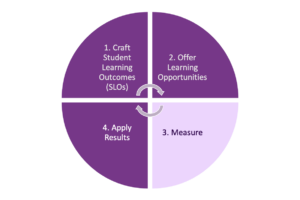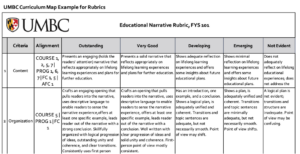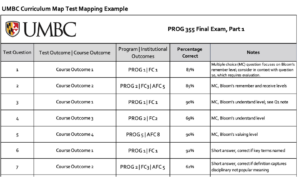Did your students learn? How do you know? Direct measures answer these questions and offer you descriptive data to help you to think about what learning students achieved and where they still need build their skills. These data help you to close the loop, that is, work towards improving your students’ learning. Subject matter experts create these tools to find out how well students demonstrated their learning in each of the relevant student learning outcomes.
For detailed instructions on how to measure student learning, see chapter 3 of A Guide to Curriculum Mapping: Creating a Collaborative, Transformative, and Learner-Centered Curriculum (Harrison & Williams 2024), or request a consultation or workshop.
 How Do You Measure Learning?
How Do You Measure Learning?
How do you know if your students have achieved your “desired results,”* the student learning outcomes you articulated in the first part of the learning assessment loop? You can find out by analyzing your direct measure results.
Direct measures look directly at student learning to find out how well students learned.
Direct measure results may be analyzed alongside indirect measures, like student satisfaction surveys, grades, retention and graduation rates, and usage data, which can offer insights about students’ experiences so you can better understand the direct learning evidence.
Direct measures typically have at least two parts:
- an assignment, which could be a prompt outlining a project, or may be a test or quiz.
- a rubric or test map to align the students’ work to the student learning outcomes.
Rubrics & Rubric Maps

A rubric is a tool that measures something subjective and qualitative; it converts that measurement to numbers, so you can compare, aggregate, and analyze the results.
When you add a rubric map to your rubric, you align each criterion to the relevant student learning outcome. After you use the rubric to assess student learning, the resulting data helps you to see if students demonstrated the learning you defined in your student learning outcomes. In the example to the right, the alignments are abbreviated and include course, program and institutional outcomes.
See the Capstone Data Example in the UMBC Curriculum Map Template package to see how rubric data might look.
Tests & Test Maps

A test map aligns test questions to student learning outcomes, so you can see how well students are achieving your “desired results.”* While students are typically interested in their total score, or the grade resulting from the test, you will want more nuanced information about how well each student and the students collectively are demonstrating the learning.
Consider reviewing test results with students, so they can see how the questions align to the student learning outcomes while gaining both personal and contextual views of the results.
*See our backward design page that explains this planning process including formulating “desired results.”
FDC Learning Assessment Resources | Student Learning Outcomes | Curriculum Mapping | Closing the Loop | Selected Learning Assessment References
Text and graphics created by Jennifer M. Harrison, Ph.D.